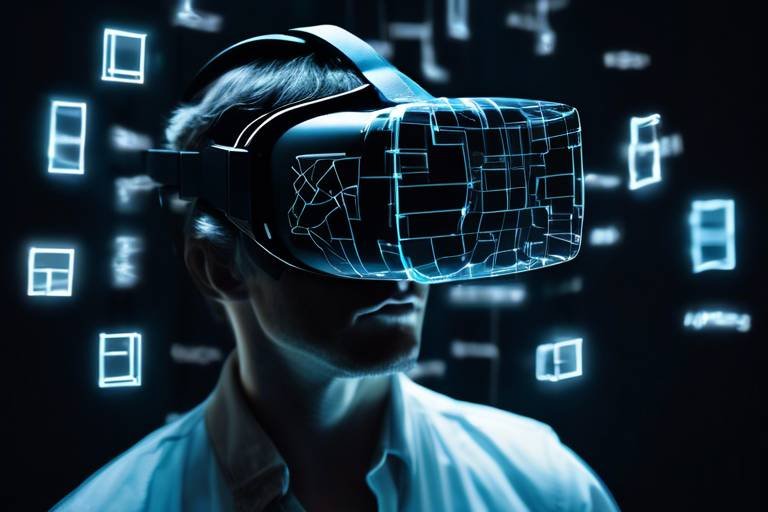Ontology – Exploring the Philosophy Behind Virtual Reality
In a world where technology is evolving at a breakneck speed, the concept of reality is being reshaped before our very eyes. Virtual reality (VR) is no longer just a playground for gamers; it has morphed into a powerful medium that challenges our understanding of existence and identity. So, what exactly is ontology, and how does it relate to this digital frontier? Ontology, the philosophical study of being and existence, serves as a crucial framework for exploring the implications of virtual realities. It invites us to ponder profound questions: What does it mean to exist in a virtual world? How do we define our identities when the lines between the physical and digital blur? These inquiries are not merely academic; they resonate deeply with our everyday experiences in an increasingly digital age.
As we traverse the landscapes of virtual environments, we encounter a myriad of experiences that compel us to reconsider our perceptions of reality. Imagine stepping into a digital realm where the laws of physics bend and twist, where you can fly, swim, or even become someone entirely different. This flexibility raises an intriguing point: if our experiences in VR feel real, can we dismiss them as mere illusions? The philosophical debates surrounding ontology in virtual reality challenge traditional notions of existence and compel us to rethink what it means to be 'real.'
Moreover, the implications of ontology in virtual reality extend beyond individual experiences. They touch on the collective consciousness of society. As more people engage with these immersive environments, the shared understanding of reality begins to shift. We find ourselves in a fascinating paradox: while the physical world remains constant, our interpretations of existence are in flux. This dynamic interplay between the real and the virtual invites a deeper exploration of identity, knowledge, and the essence of being.
In the following sections, we will delve into the intricacies of identity in virtual spaces, the role of avatars, and the ethical considerations that arise in these digital realms. Each aspect offers a unique lens through which we can examine the philosophical implications of virtual reality, ultimately enriching our understanding of existence itself.
- What is ontology? Ontology is the philosophical study of being and existence, focusing on what entities exist and how they can be categorized.
- How does virtual reality challenge traditional notions of reality? Virtual reality creates immersive experiences that can feel just as real as physical reality, prompting philosophical debates about existence.
- What role do avatars play in virtual reality? Avatars serve as digital representations of users, influencing identity construction and social interactions within virtual environments.
- What are the ethical considerations in virtual reality? Ethical issues include user consent, data privacy, and the moral responsibilities of creators in shaping user experiences.

Understanding Ontology
Ontology is a fascinating branch of philosophy that dives deep into the essence of being and existence. Imagine it as the foundation of our understanding of reality, where we ponder questions like "What does it mean to exist?" and "What is the nature of reality itself?" In the realm of virtual reality (VR), ontology takes on an even more intriguing role. As we immerse ourselves in digital worlds, the traditional boundaries of existence blur, leading us to rethink our perceptions of identity and reality.
At its core, ontology seeks to categorize and understand the various entities that populate our world—both tangible and intangible. In the context of VR, we encounter a plethora of entities, from digital avatars to virtual landscapes. Each of these elements prompts us to consider their ontological status: Are they real? Do they hold any significance in our lives? These questions are not just academic; they resonate with our daily experiences in increasingly digital environments.
To grasp the implications of ontology in virtual reality, we must first explore some fundamental concepts:
- Existence: What does it mean for something to exist in a virtual space? Is a digital avatar as 'real' as a physical person?
- Identity: How do we define ourselves when our identities can be fluid and changeable in virtual environments?
- Reality: How do we distinguish between the 'real' world and a virtual one, especially when the experiences can feel equally immersive?
As we navigate through these concepts, it's essential to recognize that the implications of ontology extend beyond mere philosophical musings. They challenge our understanding of self and community. In a VR setting, users often create and interact with avatars that may not resemble their physical selves. This leads to a unique sense of identity that is both liberating and perplexing. It raises questions about authenticity: Is the person behind the avatar the same as the one in the physical world? Or does the virtual space allow for a more genuine expression of self, free from societal constraints?
Ultimately, understanding ontology in the context of virtual reality is about more than just pondering existence; it's about recognizing how these digital experiences shape our lives and relationships. As we embrace more immersive technologies, we must confront the philosophical questions they raise, allowing us to redefine our understanding of what it means to exist in an increasingly digital age.

The Nature of Reality
The concept of reality is often taken for granted, yet when we delve into the realm of virtual environments, it becomes a complex tapestry woven from threads of perception, experience, and philosophy. In virtual reality (VR), the boundaries of what we consider "real" are blurred, challenging our traditional notions of existence. Imagine stepping into a digital world where the laws of physics bend, where you can fly through the sky or walk through walls. This is not just a thrill; it's a profound shift in how we understand reality itself.
At its core, reality can be divided into two primary categories: physical reality and virtual reality. Physical reality is what we experience in our everyday lives—it's tangible, measurable, and universally acknowledged. In contrast, virtual reality is constructed, existing only within the confines of digital frameworks. This distinction raises critical questions: Can something that is not physically present still be considered real? And if so, how do we navigate our identities and experiences within these digital realms?
As we immerse ourselves in virtual experiences, we encounter a unique phenomenon where the brain often accepts these environments as "real." This acceptance can lead to emotional responses that mimic those we have in the physical world. For instance, consider a VR game where you are chased by a digital monster. Your heart races, your palms sweat, and you feel genuine fear, even though you know that the monster is just a collection of pixels. This emotional engagement is a testament to the power of virtual reality in shaping our perceptions.
Moreover, the nature of reality in virtual spaces invites us to reconsider the philosophical implications of existence. Are our experiences in VR less valid than those in the physical world? Some philosophers argue that if an experience elicits genuine emotions and memories, it holds significance regardless of its origin. This perspective challenges us to redefine our understanding of what it means to exist and experience life.
To further illustrate this, let’s consider a few key distinctions between physical and virtual realities:
| Aspect | Physical Reality | Virtual Reality |
|---|---|---|
| Tangibility | Concrete and measurable | Intangible and constructed |
| Perception | Universally acknowledged | Subjective and variable |
| Emotional Response | Based on real-life experiences | Can be equally intense despite being simulated |
In conclusion, the nature of reality in virtual environments is a captivating subject that invites us to explore the depths of human experience and identity. As we continue to engage with these digital realms, we must grapple with the implications of our experiences and how they reshape our understanding of existence itself. Are we merely observers in a fabricated world, or do we find a new form of reality that enriches our lives in unexpected ways? The answers may lie in the evolving dialogue between philosophy and technology.
- What is the difference between physical and virtual reality? Physical reality is tangible and measurable, while virtual reality is constructed and exists within digital frameworks.
- Can experiences in virtual reality be considered real? Yes, if they elicit genuine emotions and memories, they hold significance regardless of their origin.
- How does virtual reality impact our perception of identity? Virtual reality allows users to construct fluid identities, which can influence self-perception and social interactions.

Virtual vs. Physical Existence
When we dive into the realm of virtual existence versus physical existence, it’s like stepping into two parallel universes that are constantly colliding and interacting. The virtual world, a digital playground where anything is possible, often blurs the lines of reality, leaving us to ponder: What does it truly mean to exist? In the physical realm, our existence is defined by tangible experiences, our interactions with the world around us, and the senses that guide us. However, in virtual spaces, existence takes on a new form, challenging our traditional perceptions and inviting us to explore identity in unprecedented ways.
Consider this: when you log into a virtual reality (VR) environment, you are not just a spectator; you become an active participant, shaping your reality through choices and interactions. This leads to a fascinating question: Is your virtual self any less real than your physical self? The answer isn’t straightforward. While our physical bodies are bound by the laws of nature, our virtual avatars can transcend these limitations, allowing us to explore aspects of our identity that may remain dormant in the real world.
To better understand the distinctions and overlaps between these two forms of existence, let’s break it down into some key areas:
| Aspect | Physical Existence | Virtual Existence |
|---|---|---|
| Identity | Fixed and often tied to societal roles | Fluid, allowing for experimentation and change |
| Interaction | Face-to-face, sensory engagement | Digital, often mediated through avatars |
| Limitations | Bound by physical laws and geography | Limited only by imagination and technology |
| Experience | Direct and personal | Often immersive but can be artificial |
This table illustrates how virtual existence can offer a unique lens through which we can re-examine our identities and experiences. For example, in a physical setting, your identity may be shaped by your job, family, and social circles. In contrast, virtual spaces allow you to redefine yourself, adopting new personas that may be entirely disconnected from your physical life.
Moreover, the way we perceive our surroundings in these two realms is vastly different. In the physical world, our senses provide a coherent narrative of existence. We see, touch, hear, and feel our environment in ways that ground us in reality. Virtual environments, while visually stunning and often immersive, can sometimes create a disconnect, leading to questions about authenticity and the nature of our experiences. Are we genuinely experiencing something if it's mediated through a screen? Or is the emotional response we have enough to validate our existence in that space?
As we explore these questions, it’s essential to recognize the impact of virtual experiences on our physical lives. Many individuals report that their interactions in virtual environments can influence their real-world behaviors, altering their perceptions and even their social norms. This interplay raises further philosophical inquiries: Can virtual experiences lead to real emotional connections? And if so, what does that mean for our understanding of relationships in both realms?
In conclusion, the juxtaposition of virtual and physical existence invites us to reconsider our definitions of reality and identity. While both forms of existence have their unique attributes, the lines between them are increasingly blurred. As technology advances, our explorations into these realms will likely deepen, prompting more profound philosophical discussions about what it means to truly exist.
- What is the main difference between virtual and physical existence?
Virtual existence is characterized by digital interactions and representations, while physical existence is rooted in tangible experiences and sensory engagement. - Can virtual experiences impact real-life behavior?
Yes, many studies suggest that immersive virtual experiences can influence perceptions and behaviors in the physical world. - How do avatars shape identity in virtual spaces?
Avatars allow users to explore different aspects of their identities, often leading to a more fluid understanding of self.

Identity in Virtual Spaces
In the realm of virtual reality, the concept of identity takes on a fascinating and multifaceted dimension. Unlike our physical existence, where identity is often tied to our biological attributes and social roles, virtual spaces allow individuals to construct and deconstruct their identities in ways that were previously unimaginable. Imagine walking into a digital world where you can choose to be anyone or anything—an ethereal creature, a heroic warrior, or even a version of yourself that embodies your wildest dreams. This flexibility can lead to profound questions about who we are and how we perceive ourselves.
One of the most intriguing aspects of identity in virtual environments is the fluidity it offers. In these spaces, users can experiment with different personas, often referred to as avatars. Each avatar can represent a different facet of the user’s personality, allowing for exploration and self-expression that transcends the limitations of the physical world. For instance, someone who may feel shy or introverted in real life might find empowerment in a digital persona that exudes confidence and charisma. This raises a critical question: does the way we present ourselves online reflect our true identity, or is it merely a facade?
Moreover, the construction of identity in virtual spaces is not just an individual endeavor; it also involves social interactions that can significantly influence self-perception. When users engage with others in these digital realms, they are often met with feedback that can either reinforce or challenge their chosen identities. This dynamic can lead to a rich tapestry of social experiences, where identity is continually negotiated and reshaped. For example, a user might adopt a particular style or behavior to fit in with a community, further complicating the question of authenticity. Are we being true to ourselves, or are we merely mirroring the expectations of those around us?
To better understand this phenomenon, let's consider some key factors that shape identity in virtual spaces:
- Customization: The ability to tailor avatars and profiles allows for a personalized expression of identity.
- Community Influence: Interactions within virtual communities can alter perceptions and behaviors, impacting identity formation.
- Escapism: Virtual environments can serve as a refuge from reality, enabling users to explore identities they might not feel comfortable expressing in the physical world.
This fluidity and adaptability of identity in virtual spaces highlight a significant philosophical implication: the distinction between authenticity and artifice. As users navigate these digital landscapes, they must grapple with the authenticity of their experiences. Is the joy felt through a virtual achievement as real as that achieved in the physical world? And what does it mean for our understanding of self if we can so easily shift our identities?
Ultimately, the exploration of identity in virtual spaces invites us to reconsider the very essence of who we are. It challenges the notion that identity is fixed and suggests that it is, instead, a fluid and evolving construct shaped by our interactions and experiences. As we continue to immerse ourselves in virtual realities, the implications for our understanding of identity will only deepen, prompting us to ask even more profound questions about existence and selfhood.

The Role of Avatars
Avatars are not merely digital representations; they are the embodiments of our identities in the expansive realms of virtual reality. When we step into these digital worlds, our avatars become the face of our presence, allowing us to interact, explore, and express ourselves in ways that transcend the limitations of the physical world. Imagine walking into a bustling virtual marketplace, where your avatar is dressed in the latest digital fashion, engaging with others who might be thousands of miles away. This experience is not just about the visual representation; it's about the connection and the interaction that avatars facilitate.
One of the most intriguing aspects of avatars is their ability to shape our experiences. They allow us to experiment with different identities, presenting ourselves in ways that we might not feel comfortable doing in real life. This fluidity of identity can lead to profound personal insights. For instance, a user might choose an avatar that reflects their ideal self, which can boost confidence and encourage self-exploration. However, this raises important questions: What happens to our sense of self when we can be anyone we want? Does the line between who we are and who we portray blur, or do we find new facets of our identity?
Moreover, avatars play a crucial role in social interactions within virtual spaces. They are the medium through which we communicate, build relationships, and engage in collaborative experiences. The design and customization of avatars can significantly influence how users perceive themselves and others. For example, a highly personalized avatar can foster a sense of belonging and community, while a generic one might lead to feelings of isolation or detachment. This phenomenon highlights the psychological impact that avatars can have on social dynamics.
In addition to personal expression and social interaction, avatars also serve practical purposes. They can be used to convey information about a user’s status or achievements through visual cues. For instance, an avatar adorned with rare digital items may signal a player’s experience level in a gaming environment. This aspect of avatars can create a hierarchy within virtual communities, influencing how individuals are treated based on their digital representation.
Ultimately, the role of avatars in virtual reality is multifaceted. They are instruments of identity exploration, facilitators of social connections, and symbols of status within digital environments. As we continue to navigate these immersive experiences, it’s essential to reflect on how our avatars shape not only our virtual interactions but also our understanding of ourselves and our place in the world. The journey of self-discovery in virtual reality is just beginning, and avatars are at the forefront of this exploration.
- What is the primary purpose of an avatar in virtual reality?
Avatars serve as digital representations of users, enabling them to interact, express themselves, and engage with others in virtual environments. - Can avatars affect our sense of identity?
Yes, avatars can influence how users perceive themselves and their interactions, often allowing for exploration of different aspects of identity. - How do avatars impact social interactions in virtual spaces?
Avatars facilitate communication and relationships, with their design and customization affecting users' feelings of belonging or isolation. - Are there ethical considerations regarding avatar representation?
Absolutely, as avatars can reflect stereotypes or cultural appropriations, raising questions about authenticity and respect in virtual interactions.

Philosophical Implications
When we dive into the realms of virtual reality (VR), we find ourselves in a fascinating philosophical landscape that challenges our traditional beliefs about existence, knowledge, and reality itself. At first glance, VR might seem like just another technological advancement, but it goes far deeper than that. It prompts us to reconsider what it means to be 'real' in a world where digital experiences can feel just as profound as those in the physical realm. This leads us to the age-old question: If we can experience something that feels real, does it hold any weight in our understanding of existence?
One significant philosophical implication of VR is the blurring of lines between subjective and objective reality. In the physical world, we rely on shared experiences and collective understanding to define what is real. However, in a virtual environment, individual experiences can vary dramatically. For instance, two users might enter the same VR space and have entirely different perceptions of what they encounter, leading to a situation where multiple realities coexist simultaneously. This raises questions about the nature of truth and whether it can be universally applied in such diverse contexts.
Moreover, the concept of knowledge itself is reshaped in virtual environments. Traditionally, knowledge is tied to empirical evidence and physical interaction. Yet, in VR, knowledge can be constructed through simulations and interactions that may not have any basis in the physical world. For example, consider a VR educational program that allows students to explore the human body in a way that is impossible in real life. They gain knowledge through immersive experiences, challenging the notion that learning must occur through tangible, real-world interactions.
Another layer to this discussion is the ethical implications of virtual realities. As we create and inhabit these digital spaces, we must consider the responsibilities that come with them. Who owns the experiences created in VR? What happens to the data collected from users? These questions not only challenge our understanding of intellectual property but also our moral obligations towards those who engage with these technologies. The potential for manipulation and exploitation in virtual environments highlights the need for a robust ethical framework to guide developers and users alike.
In summary, the philosophical implications of virtual reality extend beyond mere technological advancements. They compel us to re-evaluate our definitions of reality, knowledge, and ethics, ultimately reshaping our understanding of existence itself. As we continue to explore these digital landscapes, we must remain vigilant and thoughtful about the profound questions they raise, ensuring that we navigate this brave new world with both curiosity and caution.
- What is ontology in the context of virtual reality?
Ontology in VR refers to the study of being and existence within digital environments, exploring how these spaces alter our perceptions of reality. - How does virtual reality challenge traditional notions of reality?
VR creates immersive experiences that can feel just as real as physical interactions, prompting debates about the nature of truth and existence. - What are the ethical considerations in virtual reality?
Key ethical issues include user consent, data privacy, and the responsibilities of creators in shaping user experiences. - Can virtual experiences be considered knowledge?
Yes, experiences in VR can lead to knowledge acquisition, even if they are not grounded in the physical world.

Ethics in Virtual Reality
The rise of virtual reality (VR) technology has opened up an exciting frontier for entertainment, education, and social interaction. However, with great innovation comes great responsibility. The ethical considerations surrounding virtual reality are crucial, as they shape not only the experiences of users but also the broader implications for society. As we dive into this complex landscape, we must address various ethical dilemmas that arise, such as user consent, data privacy, and the moral responsibilities of creators in shaping these immersive environments.
Firstly, let’s talk about user consent. In the physical world, consent is a fundamental principle in interactions. In virtual spaces, this principle becomes even more nuanced. Users often engage with VR environments that collect vast amounts of personal data, including their behaviors, preferences, and even biometric information. The question arises: how do we ensure that users are fully informed about what they are consenting to? Are they aware of how their data might be used or shared? This lack of transparency can lead to ethical violations, making it imperative for developers to prioritize clear communication and obtain informed consent from users.
Next, we must consider data privacy. With the increasing sophistication of VR technologies, the amount of data collected can be staggering. Users may not realize that their interactions in a virtual world could be monitored and analyzed. This raises significant concerns regarding who has access to this data and how it is utilized. For instance, are companies using this information to manipulate user behavior or targeting them with ads? The ethical implications here are profound, as they touch on issues of autonomy and privacy rights. Developers must ensure robust data protection measures are in place, safeguarding users' information from potential misuse.
Moreover, the moral responsibilities of creators in the VR space cannot be overlooked. As architects of these digital realms, developers have the power to shape experiences that can significantly impact users' perceptions and behaviors. This responsibility extends to creating environments that promote positive interactions and discourage harmful behaviors. For example, VR experiences that involve violence or discrimination can desensitize users to real-world issues, leading to a slippery slope of ethical concerns. Hence, it is essential for creators to reflect on the societal impact of their designs and strive to foster an inclusive and respectful virtual community.
As we navigate the ethical landscape of virtual reality, it is crucial to engage in ongoing discussions about these issues. By fostering a culture of awareness and responsibility, we can ensure that VR technology serves as a force for good rather than a source of ethical dilemmas. The dialogue must involve not only developers and users but also ethicists, policymakers, and society at large. Only through collaboration can we address these challenges and create a virtual world that respects the rights and dignity of all its inhabitants.
- What are the main ethical concerns in virtual reality?
The primary ethical concerns include user consent, data privacy, and the moral responsibilities of creators. - How can developers ensure informed consent?
Developers can ensure informed consent by providing clear and transparent information about data collection and usage. - What role does data privacy play in VR?
Data privacy is crucial in VR as it involves protecting users' personal information and ensuring it is not misused. - Why is the moral responsibility of creators important?
Creators shape user experiences, and their moral responsibility ensures that these experiences are positive and do not promote harmful behaviors.

Impact on Human Behavior
The advent of virtual reality (VR) has ushered in a new era of interaction and experience, fundamentally altering the way we perceive and engage with our surroundings. As we don our VR headsets and step into these immersive digital realms, we often find ourselves questioning the very fabric of our reality. But what does this mean for our behavior? How does the virtual world influence our thoughts, actions, and social interactions?
One of the most significant impacts of VR on human behavior is the alteration of perception. When immersed in a virtual environment, users can experience sensations that mimic real-life encounters. This can lead to heightened emotional responses, as the brain often struggles to differentiate between the virtual and the physical. For instance, studies have shown that users can feel genuine fear when confronted with a virtual threat, such as a virtual spider or a falling object. This phenomenon raises questions about the psychological effects of VR and its potential to shape our emotional landscape.
Moreover, VR has the potential to change our social interactions. In virtual spaces, individuals can assume different identities and roles, which can lead to a sense of liberation but also to disconnection from reality. This fluidity of identity can foster creativity and self-exploration, allowing users to experiment with aspects of their personality they might not express in the physical world. However, it also poses challenges, as the line between authentic self-expression and escapism becomes blurred. Are we becoming more connected, or are we losing touch with our true selves?
Additionally, the impact of VR on human behavior extends to the realm of empathy. Immersive experiences in VR can allow users to step into the shoes of others, experiencing life from different perspectives. This can be particularly powerful in educational contexts, where users can engage with historical events or social issues in a visceral way. For example, a user might experience a day in the life of someone from a different culture or socioeconomic background, fostering a deeper understanding and empathy towards their struggles. However, the question remains: does virtual empathy translate into real-world action, or does it remain confined within the boundaries of the digital experience?
To better understand these impacts, researchers have begun to explore various dimensions of human behavior in relation to VR. The following table summarizes some of the key findings:
| Aspect | Impact of VR |
|---|---|
| Perception | Heightened emotional responses, blurring of reality |
| Identity | Fluidity and experimentation with self-expression |
| Empathy | Enhanced understanding of different perspectives |
| Social Interaction | Potential for both connection and disconnection |
As we continue to explore the implications of VR on human behavior, it becomes increasingly clear that these digital experiences are not merely entertainment; they are shaping our realities in profound ways. The challenge lies in navigating this new landscape, ensuring that we harness the positive aspects of VR while remaining vigilant about its potential pitfalls. How do we maintain our humanity in a world that blurs the lines between the virtual and the real?
- What is virtual reality? Virtual reality is a simulated experience that can be similar to or completely different from the real world, often involving a headset that immerses the user in a 3D environment.
- How does VR affect our perception? VR can heighten emotional responses and alter our perception of reality, making experiences feel more intense and real.
- Can VR help with empathy? Yes, VR can provide immersive experiences that allow users to understand different perspectives, fostering empathy towards others.
- What are the risks of using VR? Some risks include disconnection from reality, potential addiction, and the challenge of navigating identity in virtual spaces.

Future of Ontology in VR
The future of ontology in virtual reality (VR) is an exhilarating frontier that beckons us to ponder the very essence of existence in digital realms. As technology continues to evolve at a breakneck pace, the philosophical implications of these advancements become increasingly profound. Imagine a world where the lines between the physical and virtual blur so seamlessly that our understanding of reality itself is challenged. It’s not just about gaming or immersive experiences anymore; it’s about redefining what it means to *exist* in a digital age.
With the rise of technologies such as artificial intelligence, augmented reality, and advanced simulation techniques, we are on the cusp of a revolution that could reshape our ontological perspectives. For instance, consider the concept of *digital immortality*, where our consciousness could potentially be uploaded to a virtual environment. This idea raises tantalizing questions: If our thoughts and memories can exist in a virtual space, do we then continue to exist in a meaningful way? Are we still ourselves, or merely a simulation of our former selves? Such inquiries push the boundaries of traditional ontology and invite us to rethink identity and existence.
Moreover, as VR becomes more integrated into daily life, the potential for creating *hyper-realistic environments* that mimic our physical world will challenge our perceptions of authenticity. Will we be able to distinguish between what is “real” and what is “virtual”? This could lead to a philosophical crisis, where the very fabric of our understanding of reality is stretched to its limits. The implications of this are profound, not just for individual identity but for society as a whole. As we immerse ourselves in these digital landscapes, we may find that our social norms, ethics, and even relationships evolve in unexpected ways.
To illustrate the potential impacts, consider the following table that outlines some key aspects of how ontology in VR might evolve:
| Aspect | Current Understanding | Future Considerations |
|---|---|---|
| Identity | Fixed and physical | Fluid and digital |
| Existence | Physical presence | Virtual representation |
| Reality | Objective and shared | Subjective and personalized |
| Social Interaction | Face-to-face | Immersive and virtual |
As we venture into this brave new world, the ethical implications also become paramount. Who is responsible for the experiences created in these virtual environments? What happens when a user’s virtual actions have real-world consequences? The ethical landscape of VR will undoubtedly be a topic of intense debate, as we grapple with the responsibilities of creators and users alike.
In conclusion, the future of ontology in virtual reality is not just about technological advancements; it’s about a fundamental shift in how we perceive ourselves and our place in the world. As we continue to explore these digital frontiers, we must remain vigilant and reflective, ensuring that our journey into virtual existence enriches our understanding of reality rather than diminishes it.
- What is ontology in the context of virtual reality? Ontology in virtual reality refers to the philosophical study of being and existence as it applies to digital environments.
- How does virtual reality challenge traditional notions of reality? Virtual reality creates immersive experiences that can blur the lines between the physical and digital worlds, prompting us to rethink what is real.
- What are the ethical considerations surrounding virtual reality? Ethical considerations include user consent, data privacy, and the moral responsibilities of creators in shaping virtual experiences.
- Will our identities change in virtual environments? Yes, virtual environments allow for more fluid identities, which can affect self-perception and social interactions.
Frequently Asked Questions
- What is ontology in the context of virtual reality?
Ontology, in relation to virtual reality, refers to the study of being and existence within digital environments. It explores how these virtual spaces challenge our traditional understanding of reality, identity, and existence.
- How does virtual reality affect our perception of reality?
Virtual reality can significantly alter our perception of reality by immersing users in environments that can feel just as real as the physical world. This blurring of lines raises questions about what is genuine and challenges our understanding of existence.
- What are the implications of identity in virtual spaces?
Identity in virtual spaces is fluid and can be constructed in various ways. Users often adopt avatars that represent them, which can lead to new forms of self-expression and social interaction, but also raises questions about authenticity and self-perception.
- What role do avatars play in virtual reality?
Avatars are crucial in shaping user identity and experiences in virtual reality. They act as a bridge between the user and the digital world, influencing how individuals interact with others and perceive themselves in these environments.
- What are the ethical considerations in virtual reality?
Ethical considerations in virtual reality include user consent, data privacy, and the responsibility of creators to ensure safe and respectful environments. These issues are vital as virtual experiences become more immersive and impactful.
- How does virtual reality impact human behavior?
Virtual reality can alter human behavior by creating immersive experiences that influence emotions and perceptions. This can lead to changes in social norms and interactions, as users navigate these new realities.
- What is the future of ontology in virtual reality?
The future of ontology in virtual reality is likely to evolve with technological advancements, prompting ongoing discussions about existence and identity. As VR technology grows, so will the philosophical implications surrounding our understanding of reality.



















